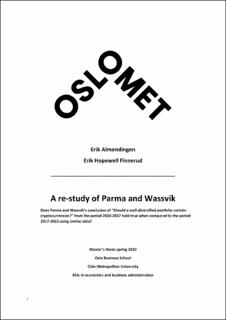| dc.description.abstract | This study reevaluates the conclusions of Parma and Wassvik's thesis, which examined the
performance of cryptocurrencies as investments from 2010 to 2017. The objective was to
determine whether cryptocurrencies remain a profitable investment opportunity in the
subsequent period from 2017 to 2022 and their suitability for inclusion in a diversified
portfolio, considering the significant volatility in the crypto market in recent years. In
addition, we constructed our own portfolio to reflect the average benchmark of crypto
investors, as not all investors have access to the MSCI International World Price Index used
in Parma and Wassvik.
Upon analyzing the data, we find that the original thesis's conclusion still holds true. While
cryptocurrencies, particularly Ethereum and Bitcoin, have demonstrated the potential for
higher returns compared to traditional assets, their performance has diminished during the
2017-2022 period. Although the variance has decreased, indicating lower volatility, the
significant decrease in returns has impacted the overall performance. This can be attributed
to the high and constant weekly price growth observed in cryptocurrencies from 2010 to
2017, which resulted in high variance and average returns. In contrast, the 2017-2022 period
witnessed both negative and positive price changes with less extreme observations, leading
to lower returns and lower variance.
Despite the decrease in risk and return compared to Parma and Wassvik's findings,
cryptocurrencies still offer potential benefits when considering the risk-return tradeoff.
However, their performance metrics do not surpass those of the previous period. It is worth
noting that the data used in Parma and Wassvik's study were influenced by extreme positive
observations (outliers), such as the rapid increase in crypto prices in 2017. In our study, we
capture both dramatic price increases and decreases, resulting in fewer outliers and more
reliable data with more conclusive metrics, affirming that cryptocurrencies outperform all
assets despite their variance.
In conclusion, our study with new and more reliable data confirms that cryptocurrencies
should be included in a well-diversified portfolio and have demonstrated superior
investment potential compared to alternative assets available in our dataset.
Cryptocurrencies have also proven to be a favorable investment compared to the market
portfolio constructed to represent the average investment opportunity for crypto investors
However, it is crucial to acknowledge that our research focused on the period from 2017 to
2022, and further investigations should continue to monitor the long-term investment
performance of cryptocurrencies for a comprehensive understanding of their potential. | en_US |
